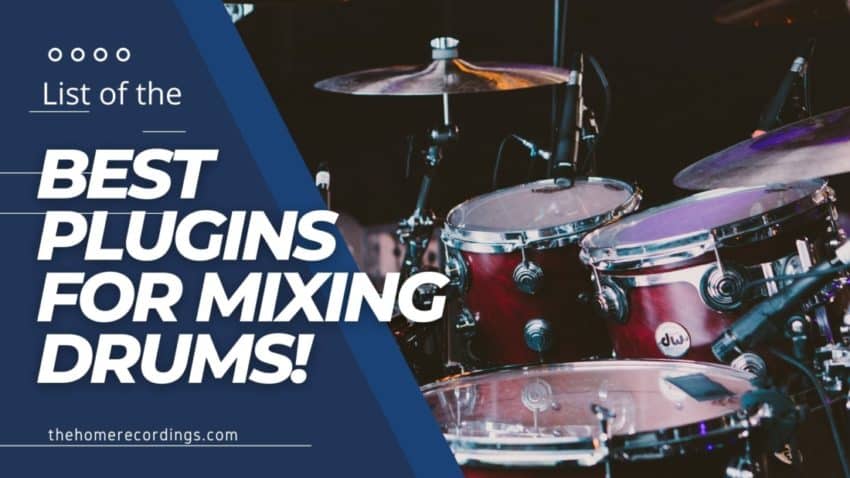Last updated on March 13th, 2024 at 11:32 pm
Mixing drums is one of the more daunting tasks for beginner music producers, from setting the levels correctly to using EQ and compression the right way, and more, and using the right plugins is essential.
Note: You don’t need dozens of plugins since just one or two of each type (compressor, EQ, Gate, Saturation, etc.) will suffice. It is much more useful to really learn how to use the ones you have instead of going out and purchasing more.
Having said that, in this article, I will be listing Compressors, EQs, Gates, Saturation VSTs, Reverbs, and also Plugins designed strictly for bus processing to help you achieve a better drum sound.
Let’s get started!
Best All-Rounder Plugin
Waves CLA Drums
Plugin specifically designed for Mixing Drums!
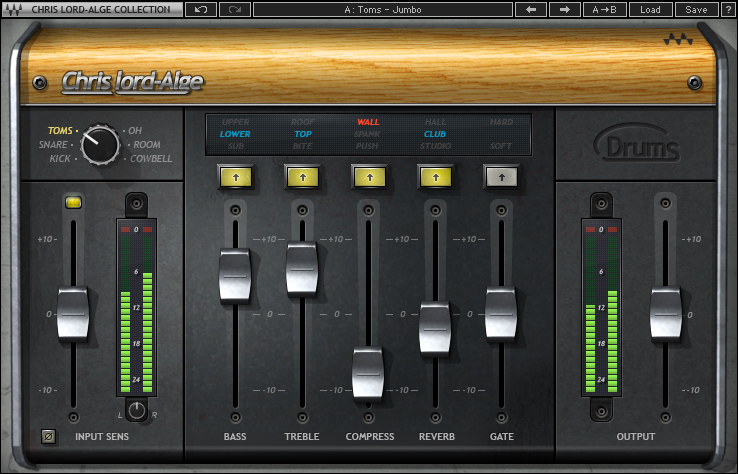
Price: $35.99.
Chris Lord-Alge is arguably the best-known mixing engineer out there and he worked with Waves to create this plugin with the idea of helping people get a good drum sound in a much simpler and quicker way.
The CLA Drums comes with different EQ Presets which you can choose by turning the knob on the left, and each one is meant for mixing a different part of the kit; Kick, Snare, Toms, Overhead, Room, Cowbell.
These presets have a different EQ setting each and then you can use the built-in faders to adjust the frequencies and effects any way you want.
The plugin includes an Input Sensitivity slider, as well as Bass and Treble sliders, and then three additional sliders which let you add compression, reverb, and a gate.
There are three color-coded presets for bass EQ, treble EQ, compression, and reverb, each with a different and very descriptive name, and you can use each fader to control how much of the effect you want.
Lastly, it comes with a Master Output.
User Interface: It features one of the simplest interfaces I’ve ever seen since it only offers a handful of sliders and the color-coded presets on top, making it especially useful for beginners.
Character: The character varies depending on the preset you choose, but it doesn’t add a “vintage” vibe and sounds rather transparent.
Distinctive Features:
- Built-in presets for quickly adjusting the sound of the drum track.
- All-in-one plugin: EQ, Compression, Effects, and a Gate.
Uses: This plugin was specifically designed to mix drums, so that’s exactly what you should be using it for, especially if you want to be able to mix quickly.
You can get the CLA Drums here: Waves Website, Sweetwater.
Best Compressors Plugins for Drums
THR Compactor
Powerful Compressor with Tempo-sync features!
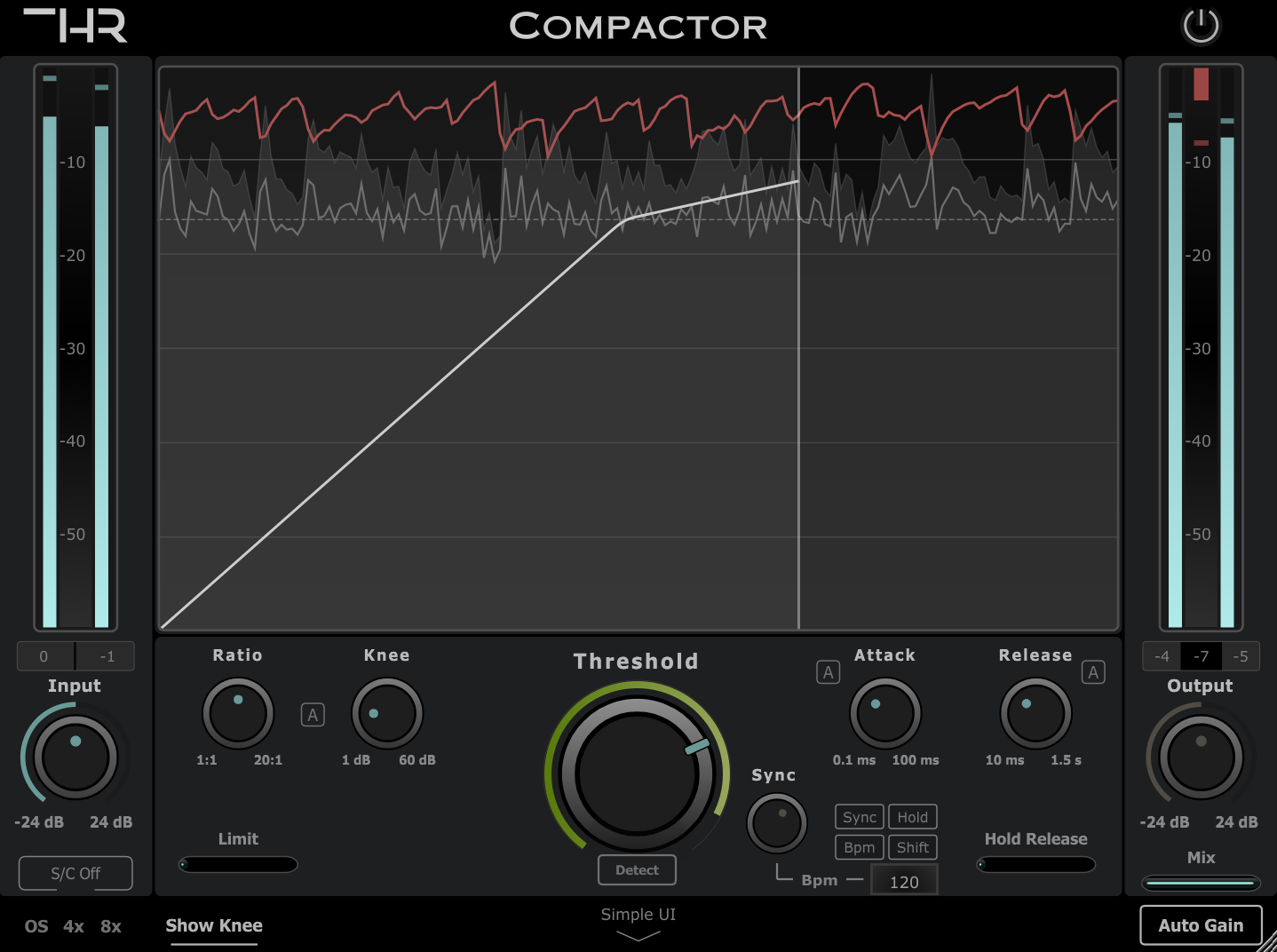
Price: $49.99.
The THR Compactor is a compressor that offers a ton of functionality at a very low price!
Its automatic gain makeup feature works a lot better than the one found on most other compressors, and this lets you to dial in the needed compression without having to worry about the output volume, and contrary to other compressors, it doesn’t just take into account the threshold and ratio in order to calculate the makeup, but also attack and release times, the knee, the mix percentage, and more, ensuring that you have a consistent output level no matter the settings.
The Compactor offers two distinct interfaces: A Simple UI and an Advanced UI. Let’s go over what the simple UI has to offer:
Simple UI
Designed to let you dial in the ideal compression levels as fast as possible, the Simple UI focuses on the use of presets with a range of set parameters tailored for specific input signals, such as drum busses, guitars, vocals, etc.
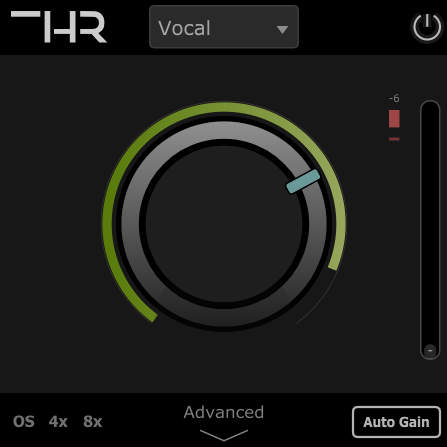
Simple UI Features:
- Threshold Control: Adjust the threshold control to achieve the desired level of compression.
- Tailored Presets: Included are a range of presets tailored to various audio sources, including drum buses, guitars, vocals, bass, and more.
- Auto Makeup: When enabled, you don’t need to worry about the output level changing while adjusting the compression since the Compactor does this for you.
- 4x and 8x Oversampling: Removes aliasing, improving the clarity of your compressed audio.
The Simple UI lets beginner producers learn about dialing in compression without getting overwhelmed and it’s also the perfect tool for seasoned producers to achieve a faster workflow.
Advanced UI

Here is where the Compactor provides you with granular control over the compression as well as access to some advanced features which are not that common in other compressors (such as synchronizing to the project’s tempo, holding the release, and more).
Advanced UI Features:
- Histogram Display: The histograms visually represents the input, compression, and post-compression audio levels.
- Automatic Controls: Auto Knee, Attack, Release, and even Threshold controls (you can see it moving in real time).
- Oversampling: 4x and 8x oversampling to reduce aliasing.
- Gain Reduction Limit: Manually set the maximum gain reduction in dB and Compactor will never compress more than that.
- Tempo Sync Functionality: Compactor can sync the release to your project’s tempo, or even hold the release based on the Bpm to create some interesting rhythmic compression patterns.
Lastly, Compactor comes with a 7-day free trial, so make sure to give it a try!
Get the THR Compactor here.
FabFilter Pro C2
Industry Standard!

Price: $179.
The FabFilter Pro C2 is one of the best Compressor VST Plugins currently available, be it for mixing Bass, vocals, drums, bus compression, and more.
Featuring multiple different presets each meant for a specific purpose, such as mastering, vocals, bus compression, for adding punch, and more, the C2 easily lets you affect the dynamic range of the track quickly and in great detail.
In addition to this, it comes with all the typical compression controls such as Threshold, Ratio, Attack, and Release, while also featuring Makeup Gain (which can be set to Auto or you can adjust it manually).
User Interface: The interface on the C2 looks absolutely stunning and modern and you can choose between a compact interface that looks more like a traditional compressor, or even a full-screen mode with a spectrum analyzer, gain reduction curve, and much more.
Character: The C2 doesn’t really add a lot of its own personality to the mix, or in other words, it doesn’t color the sound as other compressors do but rather allows you to go from a very gentle compression when using the Mastering Preset, to a more drastic compression when using the Punchy preset, for example, and all of this without coloring the sound too much.
One thing I’d like to mention also is the Makeup- or Auto Gain function which works better than in most other compressor plugins since it also takes into account attack and release times which affect the level of the signal.
Distinctive Features:
- Oversampling (2x and 4x).
- Look Ahead control.
- Hold Control.
- Multiple Interface options (more limited, full screen, etc.).
- Side-chain compression with built-in stereo link capabilities.
- MIDI Learn.
- A/B Switching.
Uses: Not only is the Fabfilter Pro-C2 an excellent compression plugin for getting punchier drums or a more upfront lead vocal, but it’s also a great mastering Compressor, especially when using the “Mastering” preset.
Get Fabfilter Pro C2 Here: Pluginboutique, ADSR Sound, Sweetwater.
Waves CLA-76
The “all” setting produces an extremely punchy drum sound!
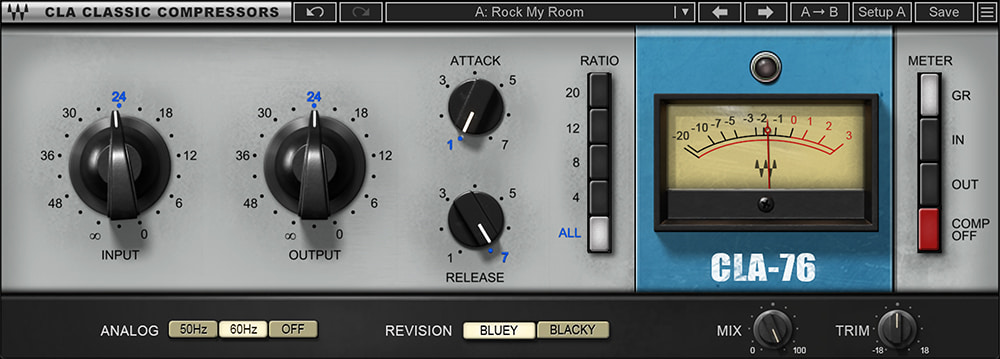
Price: $29.99.
The Waves CLA-76 is modeled after the legendary UREI 1176 vintage compressor/limiter and offers all of the same characteristics in a smaller and more convenient plugin format.
At the bottom of the plugin, you can choose between the two Revisions: Bluey and Blacky, with the Bluey being based on the oldest version of the hardware compressor which sounds a bit more distorted and grittier, and with the Blacky being based on the newer version of the 1176 which sounds a bit cleaner.
As far as controls go, the CLA-76 offers an Input knob, which controls the level of the signal coming into the compressor, an Output knob, which essentially is the Makeup Gain, Attack and Release knobs, and lastly five different Ratio settings (4, 8, 12, 20, and “ALL”).
The “All” setting recreates the original hardware’s “All-Ratio-Buttons-In” mode which results in a very aggressive compression with a decent amount of distortion and produces a super punchy drum sound.
Important note: The Attack and Release knobs are very counter-intuitive since turning them clockwise increases the speed, which is the opposite of how most compressors work, so keep that in mind.
The metering can be switched from input, output, and GR (how much gain is being reduced), and on the bottom, it includes three switches: 50Hz, 60Hz, and Off, and these essentially introduce a bit of analog sound (I always keep it Off since the plugin naturally saturates the sound slightly giving you a nice and warm analog feel).
Lastly, the newer releases of the Waves CLA-76 now also include a Mix knob for easy parallel compression and a Trim knob for quick level adjustment.
User Interface: The Waves CLA-76 is one of the simplest plugins in existence since it doesn’t feature a lot of built-in controls, making the interface extremely clean and simple, which is also why I like it so much since it works really well but doesn’t make you jump through a lot of hoops to get the most out of it.
Character: Since it’s based on the old 1167 hardware unit, it definitely has some grit and saturation to it, making it sound warm and giving you a slight analog feel even if you don’t engage the “analog” switches (50Hz and 60Hz).
Distinctive Features:
- Naturally saturates the sound.
- Includes two Revisions (Old and New ones).
- Mix control for easy parallel compression.
- Trim control for quick level adjustment.
Uses: The CLA-76 can be used on virtually any track, but it’s especially good on bass and drums because of its super-fast attack times, but it’s also a good choice for getting tighter vocals and guitars.
You can get the Waves CLA-76 here: Waves Website, Sweetwater, Best Service.
TDR Molotok
Best Free Compressor for Drums with a lot of Character!
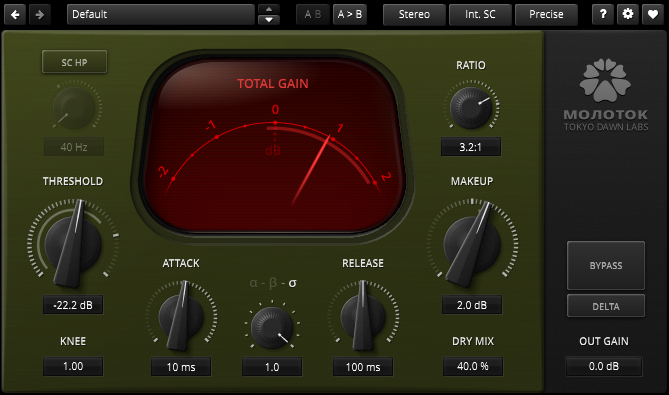
Price: Free or $50 for Molot GE Edition.
Molotok, the free version of the Molot GE edition, is a compressor designed to add grit and character to your tracks, making it an ideal choice for acoustic drums and electronic drums as well, in fact, I reach for it a lot when I’m mixing synthetic drum sounds since it makes them stand out in the mix much more.
That being said, if you’re looking for a transparent-sounding compressor, this one is definitely not it!
It features typical compressor controls such as Threshold, Ratio, Attack, Release, Knee control, Dry/Mix control for easy parallel compression, as well as a Makeup Gain knob.
Let’s quickly talk about some of its features since it offers a lot, many of which aren’t even present on premium compressors, starting with the knob between attack and release labeled “α-β-σ”, or Alpha, Beta, Sigma, which changes many compression parameters to create different compressor styles.
It also offers sidechain capabilities with a high-pass filter for the sidechain, which is usually only available in premium plugins, A/B testing, Stereo or Mono compatibility depending on the signal, and it also lets you choose a more “Economic” mode if your CPU is struggling, or even a “Live” mode which introduces zero latency.
You can use the sidechain to, for example, compress the bass when the kick drum is hitting to make room for it since they both generally sit in the same frequency range.
User Interface: Although the Molotok offers plenty of built-in features, the interface is still not cluttered at all and really simple to understand. What’s more is that on the Threshold knob you can see the signal level, allowing you to very quickly dial in the Threshold. Lastly, the Attack and release controls are configured in such a way that you have much more granular control over the initial- or lower times, which is where you generally need to fine-tune things.
Character: The Molotok definitely adds a lot of character in the form of “Grit” and “Warmth” since it really saturates the signal as soon as compression starts kicking in. In fact, even without compression working and only having the plugin engaged it already introduces some coloration.
Distinctive Features:
- A/B testing.
- α-β-σ control (changes a lot of parameters).
- Live, Economic, and Precise modes (no Latency, low CPU usage, More CPU).
- Sidechain and Parallel compression.
- High-pass Filter on the Sidechain.
Uses: This is the perfect kick drum compressor since it adds a bit of saturation and coloration to it in the process, helping it stand out more in the mix. Of course, it can also be used on the snare drum or even drum bus as well and the results are excellent.
If you’re looking for a free compressor for taming your drum hits and adding a lot of character to them, be it on single tracks or on the drum bus, then Molotok is by far the best way to go since it sounds absolutely phenomenal!
You can get Molotok here: TDR Website.
If you’re interested in getting the premium version Molot, then you can purchase it here: Pluginboutique ($30), TDR Website ($50).
Best EQ Plugins for Drums
EQs are an absolute must for mixing drums since they allow you to deal with drum bleed, remove low-end frequencies to prevent low-end buildup, enhance kick- and snare hits, and generally remove or lower any unwanted frequencies that might be poking their head out too much.
FabFilter ProQ 3
Best-sounding EQ Plugin Currently available!
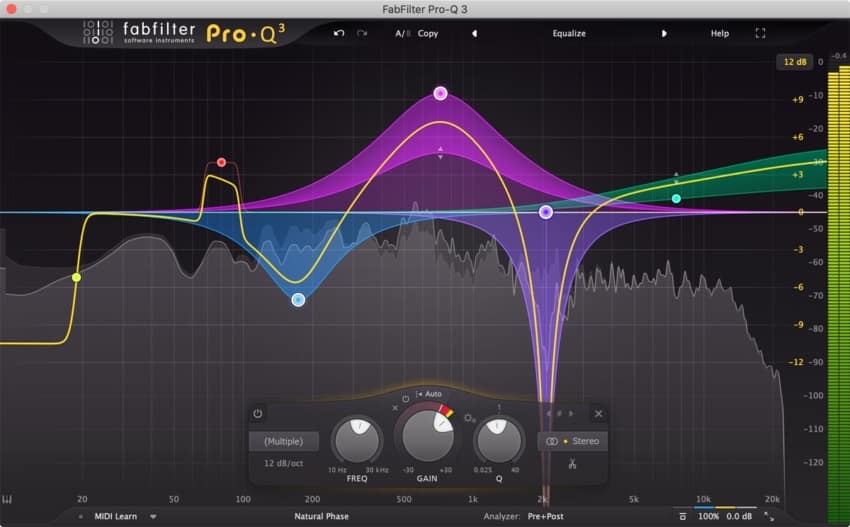
Price: $179.
The Fabfilter ProQ has by far the best interface out of all the EQs I’ve tried (this is quite common for all FabFilter plugins) and it features a fully customizable spectrum analyzer, and not only that but it also sounds ridiculously good!
To create nodes you simply double-click on the screen or click on the middle line and then drag up or down. It’s also worth mentioning that the node creation is frequency-specific, meaning that depending on where you click it will create one using a different filter shape.
For example, clicking on the low end (say 50Hz) will create a high-pass filter, whereas clicking at 2kHz will create a bell-shaped filter, and on the high-end, it will create a shelving EQ.
In addition to this, the Pro-Q 3 lets you process the stereo channels, or just right or left, mid, sides, etc., making it very versatile!
Of course, it comes with lots of built-in presets, A/B testing, and even MIDI Learn if you want to be able to control the nodes using a knob or a fader via an external controller.
User Interface: One of the reasons the Pro-Q 3 is loved by everyone is because of its interface: It’s resizable (on Windows you can drag the window, on Mac you have to select from the default sizes), and it’s very intuitive because of how the node creation system works, and the frequency spectrum analyzer is absolutely fantastic, letting you not just hear how the sound is getting affected but also see.
Character: It’s a very fidelity-focused EQ and doesn’t really add any coloration or character of its own.
Distinctive Features:
- Best Node Creation system out there (Frequency-specific).
- A/B Testing.
- MIDI Learn.
- Process Stereo, Left, Right, Mid, and Side channels separately.
Uses: This is by far the most powerful and best-sounding EQ currently available that also provides a very intuitive and quick workflow, which is why I think that it can be used for everything, be it mixing drums, the drum bus, vocals, guitars, basses, and even mastering.
Pro tip: You should always cut the frequencies that you don’t like before boosting the ones that you feel need boosting to avoid unnecessary frequency buildup.
Get the Fabfilter ProQ Here: Pluginboutique, ADSR Sounds, Best Service, Sweetwater.
Electra EQ by Kush Audio
Simplest Drum EQ out there (Best for Kick Drum)!
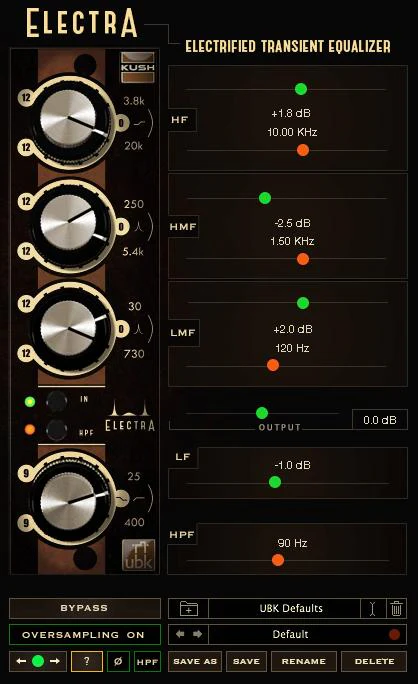
Price: $149.
If you don’t like dealing with big interfaces and just want to rely on a handful of knobs, then the Kush Audio Electra EQ will serve you well since not only does it feature just 4 knobs, and you can’t even see the input levels or how it’s affecting the sound, meaning that you will be relying entirely on your ears (which makes sense).
It offers four filters: A sweepable high-shelf filter sweepable from 3.8kHz to 20kHz, a sweepable High-mid bell-shaped filter from 250Hz to 5.4kHz, a sweepable Low-mid bell-shaped filter from 30Hz to 730Hz, and a sweepable High-Pass or Low-shelf filter from 25Hz to 400Hz.
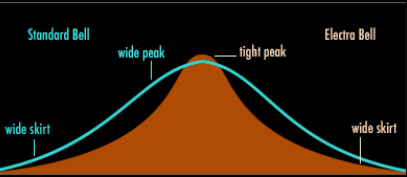
One thing that is worth noting about Electra is that it doesn’t use a Standard Wide-Q bell but instead uses what they call a “Proportional Q bell”, where the base, or skirt, is just as wide but it gets narrower at the peak when compared to the standard one, and the interesting thing is that it gets tighter the more you turn up the EQ, and this wide-AND-tight curve imparts a sculpted sound that is both aggressively punchy and silky smooth.
Lastly, it features a Master Output Gain and oversampling, and you can save your settings as presets.
User Interface: The user interface on Electra is as clean as it gets since it only features 4 knobs (technically 8 if you count the black outer knobs to adjust the frequency). This makes it extremely easy to use and learn.
Character: Electra is very “transparent” sounding and doesn’t really add a whole lot of character or coloration to the signal.
Distinctive Features:
- Only 4 EQ filters (easier to use).
- Sweepable filters.
- Oversampling.
Uses: What stands out the most about Electra is the Low Shelf filter since it adds that “thump” to the kick drum without any effort, plus it’s just as easy to improve the sound of the snare drum and you only need to turn a few knobs. It’s also an excellent plugin for synthetic drums and bass sounds (Basically, it’s excellent at boosting the low-end without mudding up the mix).
You can get Electra here: The House of Kush.
MEqualizer by Melda Production
Best Free 6-Band EQ out there!
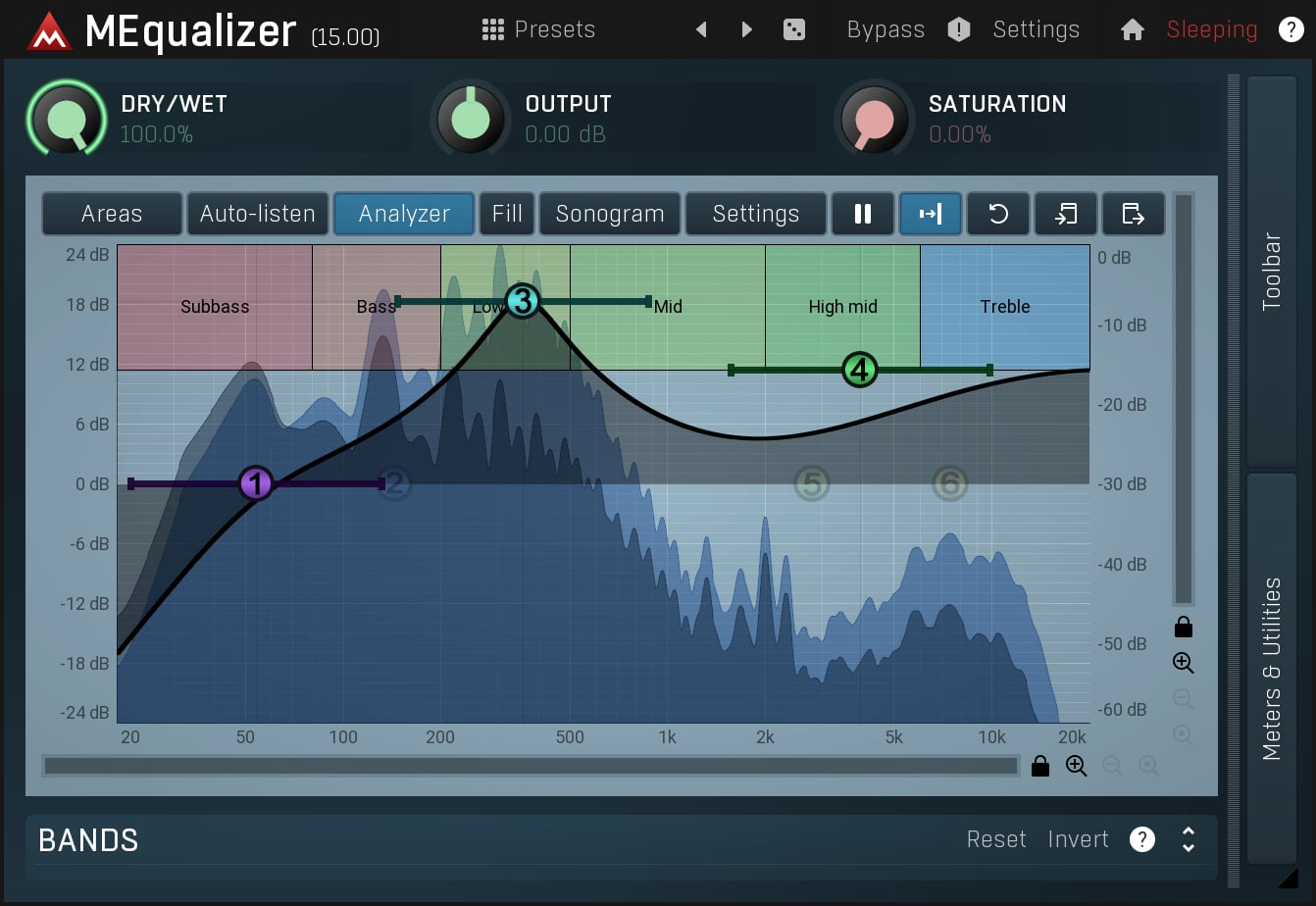
Price: Free or $109 for the Premium Version.
The MEqualizer is a 6-band EQ that’s very easy to use and features 9 filter types for each band that allow for quick adjustment, integrated tube saturation, and harmonics control, plus it also includes a visualization engine with classic meters and time graphs, and a powerful spectrum analyzer and sonogram.
Not only does it process mono and stereo signals but also mid/side for stereo field processing, up to 8 channels of surround audio, and even up to the 7th order ambisonics with a total of 64 channels.
One extremely useful and interesting feature is the one called “Areas” where the plugin shows you in the frequency spectrum where every instrument generally “lives”.
Here’s an example with the Drums:

If you’re not still familiarized with the frequencies that affect specific parts of the kit, then enabling the Drum Area can definitely help.
Another very useful feature is the “Utilities” section where you can engage a Limiter, do A/B Testing, and use the A to H switching, where you can have up to 8 instances of the plugin, copy/paste the A to H slots and freely switch between them.

When downloading the MEqualizer, not only do you get that plugin but literally 36 additional ones for completely free (you need to download the installer and there you can choose which one you want or if you want all the free ones).
The only con about these free plugins is that they come with a display ad on the bottom, but you truly are getting a fantastic set of plugins for free.
User Interface: While I truly think that the MEqualizer is in a different league as far as Free EQs go, the interface is a bit more confusing than some other plugins, partly because of the insane number of built-in features which complicate the navigation and clutter the interface, which is both good and bad. If you’re just getting started, this one might take you a bit longer to wrap your head around.
Character: It’s an EQ that mainly focuses on fidelity and doesn’t really impart any “character” to the sound like the old analog EQs did.
Distinctive Features:
- A/B Testing.
- A to H Switching.
- Built-in Limiter and saturation.
- The Areas feature is something that no other EQ offers.
- Up to 64 channels.
Uses: This EQ can do it all and there’s not anything particular that I’d use it for since it just works well! I would generally recommend reaching for it, however, if you don’t want to have to do the guesswork of finding where the frequencies are that improve the bass “kick” sound, for example, since you can simply enable the Drum Area to find it.
Get the MEqualizer here: Melda Production.
If you like Melda Production and want to try another EQ that they have to offer (more built-in features and better overall), then check out the MEqualizerLP.
Best Saturation Plugins for Drums
Saturation come really come in handy for drum processing, be it on individual tracks or on the entire drum set (bus).
Saturation can often help beef up tracks that sound muddy or dull and you can also mix it in with the dry signal, for instance on the snare drum, to make it stand out more.
Decapitator by Soundtoys
The Absolute best Saturation Plugin!
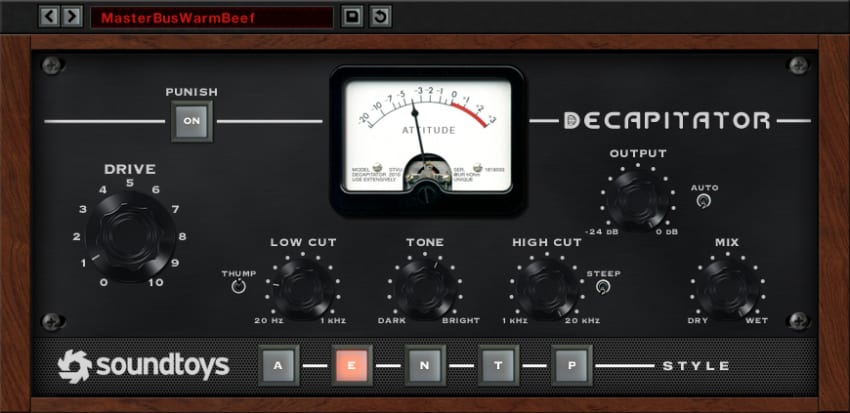
Price: $199.
Decapitator is a saturation plugin that can go from very slight and warm sounding to an almost distortion-like sound that tears your mix apart!
It comes with the “Auto” output feature which simply links the drive and output together so that when you increase the Drive (Saturation) it automatically lowers the output level so that the audio doesn’t clip and blow your speakers out.
In addition to this, it features a “Thump” switch, which does just what it says, Low-Cut, Tone, and High-Cut knobs, and a mix knob for parallel saturation (which is why I think it’s such a good plugin for mixing drums since you can blend both the dry and saturated signals).
At the bottom of the plugin, you can see different letters each representing a different preset: “A” models the Ampex 350 Tape Drive preamp, “E” is based on the Chandler Limited TG channel, and then there are 3 more presets (“N”, “T”, and “P”) each modeled after a specific hardware unit.
User Interface: The decapitator offers a very clean interface with just a handful of knobs and easily accessible presets, making it a super easy saturation plugin to use.
Character: Depending on the preset you go with since each one emulates a different hardware unit, it adds different types of character and coloration.
Distinctive Features:
- 5 Presets modeling different hardware units.
- Parallel saturation.
- Linked Drive and Output channels.
Uses: Blending the saturated signal with the dry one can often give you the best results, which is why saturation and distortion effects go well with drums. Weaker hits can be beefed up, harsh hi-hats can be softened and thickened, layers can be squashed together, and entire busses can be glued into one cohesive drum unit.
Get the Depatitator here: Pluginboutique.
Saturation Knob by Softube (Windows, Mac)
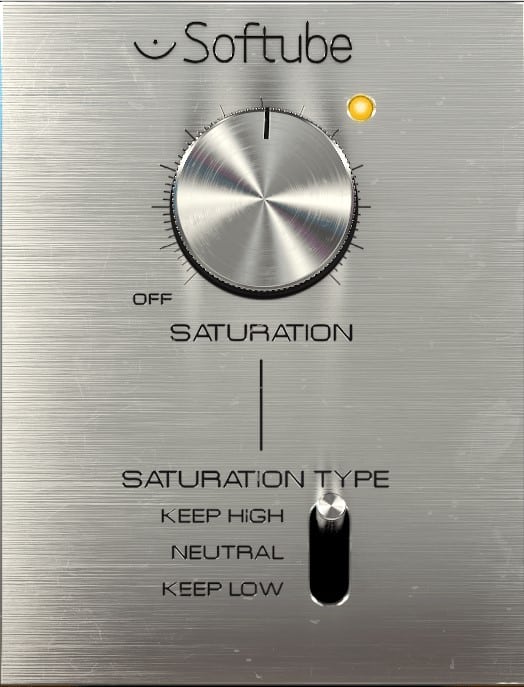
Price: Free.
The saturation knob is literally one knob that allows you to add some warmth and shimmer to the vocals, guitar, and any other track you’d like.
Just don’t go overboard with the saturation, if it starts sounding distorted, dial it back down a bit, unless that’s what you’re going for.
One huge issue I have with this plugin is not the plugin itself, but all the hoops they make you jump through to be able to use it.
You have to register with them, also register with ilok.com and then link those accounts.
AFTER that you have to download the gobbler app and install the plugin, and now you can finally use it!
It’s an easy saturation plugin to recommend if you’re willing to go through the registration process.
While no other plugin beats the Simplicity of the Saturation Knob, it’s also a tad limited. If you find yourself needing something a little more powerful, then I’d recommend Saturate by Eventide. It’s definitely a step up, both in quality as well as in the number of built-in features, etc.
User Interface: If you’re looking for a simple-looking interface, the Saturation Knob has got you covered since it only features a knob and a switch, this makes dialing the saturation you need a breeze and you can easily give more personality to the kick drums, snare drums, or the entire drum buss.
Character: It can add a lot of saturation and has a bit of an analog vibe to it.
Distinctive Features:
- 1 Knob.
- 3-way switch to control the saturation type.
Uses: I would recommend using it to only add warmth to the drum tone because you can easily go overboard with the effect since it doesn’t feature any in-depth controls. I tried it on single parts of the kit, such as the kick drums, but it also works well on the drum channel (bus).
You can get the Saturation Knob here: Softube.
Best Gate Plugins for Drums
Gates can make or break your drum mix, but when used correctly they can help you clean up the sound of the drums and remove a lot of background noise.
Fabfilter Pro-G
Best overall gate VST currently available!

Price: $179
Fabfilter is one of the best plugin companies in the world with hit products such as Pro-Q 3, Pro-R, Fabfilter Saturn, and more. The Pro-G is an all-in-one gate and expander plugin that gives users great versatility and everything you need in a gate plugin.
It offers super flexible side-chain routing, precise metering (which is something all FabFilter plugins excel at), and six carefully tuned expander/gate algorithms, including upward expansion and ducking.
User Interface: The Interface has a ton of functionality but is not as intuitive as other gate plugins. It has a faint graphical display in the center that shows both the ADSR of the control knobs and the input signal, the main control is the threshold knob which shows you the volume of the signal, and the ratio knob below the threshold allows you to use the plugin as an expander or a gate (gate is infinity on the threshold).
Distinctive Features:
- Lookahead: The lookahead knob, while it gives you a small latency, allows the gate to react even faster than normal which improves its function.
- Hold: Not every gate plugin has a hold function, which boggles me because it is useful in all cases. Pro-G has a hold button that will allow you to work with certain drum hits that have an ADSR that’s a bit more rectangular in its shape.
Uses: Gates can help you clean up the drum mix by removing unwanted background noise, just be careful not to go overboard with it since it can absolutely mess up the mix.
You can get Fabfilter Pro-G Here: Pluginboutique, ADSR Sounds, Sweetwater.
Floorfish
Rudimentary Gate Plugin that is ideal for beginners!
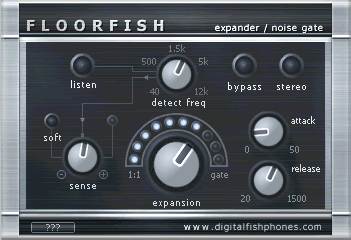
Price: Free.
FLOORFISH is a simple expander/gate plugin that is easy to set up and that offers a broad variety of processing capabilities, ranging from slight expansion, background noise attenuation, to extreme gating effects.
What’s different from similar units is the ability to scan the source and adjust the transition curve accordingly.
While it may be quite limited when compared to its premium counterparts, it really does work well, which is why I think that it deserves a spot on this list.
User Interface: Although the interface may look extremely dated and super pixelated, it’s still very intuitive and lets you access everything you need without having to go menu-diving.
Distinctive Features:
- Frequency Detect.
- Extremely easy to use.
You can download Floorfish here: Digital Fish Phones.
Best Reverb Plugins for Drums
If the acoustics of your studio are not creating satisfying drum ambiance and your tracks are lifeless and dry, you can use reverb to make your kit sound like it was recorded in a bigger, more reverberant space, while keeping it sounding natural and organic, and it’s also the only way to get that HUGE “stadium-like” snare sound.
Valhalla Room
Best bang-for-your-buck Rever Plugin!
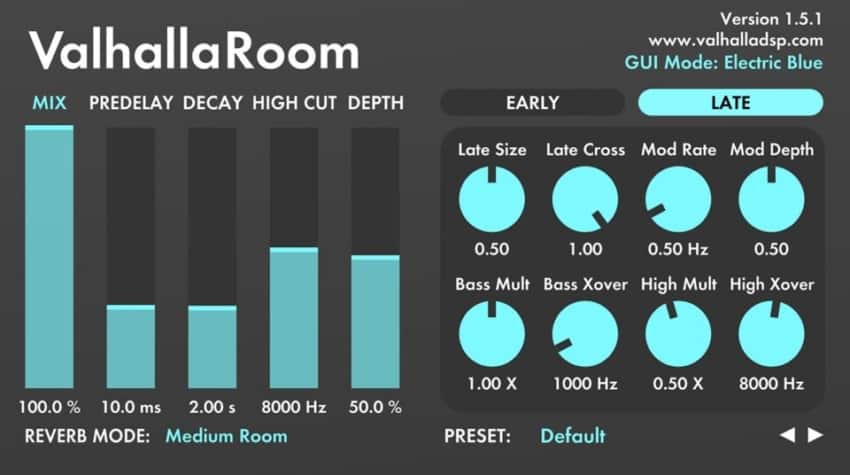
Price: $50.
Valhalla Room is a Digital Stereo algorithmic reverb that every producer should at least consider.
It’s not only great for film scoring or for giving orchestras a big sound, piano, vocals, or other instruments, but I find it to be extremely useful for mixing drums (I mainly like it on the snare).
What Valhalla Reverb excels at is Simplicity and overall Effectiveness, since it only features a handful of controls, such as; Predelay, High Cut, Depth and Decay, and you can mix the Early and Late reflections, making it easy to dial in the room size.
Lastly, it also features different modes, such as; Normal Room, Large Room, Dark Chamber, etc.
User Interface: The user interface is very clean and features all of the needed controls right on the main window. You can, however, change the color scheme quite easily.
Character: The Valhalla Reverb is a very natural and transparent-sounding reverb that doesn’t really affect the sound in any way.
Distinctive Features:
- Lets you control the early and late reflections with ease.
- Includes Great-sounding Presets.
Uses: As far as mixing drums go, I prefer using Valhalla on the Snare drum when I’m going for that big hall kind of sound, but it works really on literally any track.
You can get the Valhalla Room here: Valhalla DSP.
MConvolutionEZ
Best Free Convolution Reverb!
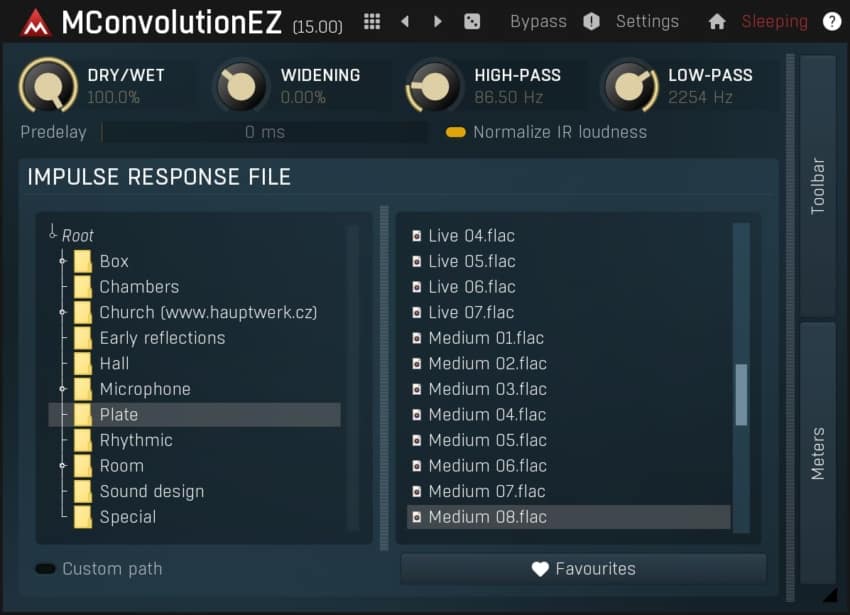
Price: Free with an available premium upgrade.
As the name implies, this is a convolution reverb designed to be simple to use. It’s worth noting that there’s also a premium version of this plugin available, the MConvolutionMB, which comes with a lot more built-in features.
While the interface itself may not be the most eye-catching you’ve ever seen, the reality is that it sounds amazing (probably way better than many paid plugins as well).
It offers an immense range of impulse responses for rooms, halls, guitar cabinets, plates, churches, and a lot more, which gives you a lot of versatility at the time of adding the effect.
Sadly, it doesn’t offer as much control over the signal as some other convolution reverbs do, and you only get a Dry/wet knob as well as one for Widening, and HP & LP filters.
Oh, and I think it’s also worth mentioning that the MConvolutionEZ comes as a part of an entire effects bundle which includes around 37 free high-quality plugins.
User Interface: Although I absolutely love Melda Plugins, the interface isn’t their strong suit, generally speaking, and in the case of their Convolution Reverb, it’s not particularly great-looking, but it really, REALLY works and sounds great.
Character: Convolution reverbs are designed to place an audio source in a modeled space using impulse responses, so they don’t really add any “character” or coloration but rather just give you the feeling that the instrument is in that specific room.
Distinctive Features:
- Visualization engine with classic meters and time graphs
- A to H Switching (have 8 instances of the plugin running and go through them as if they were “presets” for quick comparison.
- MIDI Learn.
- M/S, single channel, up to 8 channels surround and up to 64 channels ambisonics processing.
Uses: Convolution reverbs are designed to conveniently place an audio source in a modeled space using impulse response libraries, which works extremely well on acoustic drums, especially the snare.
You can get MConvolutionEZ Here: Melda Production.
Best Plugins to use on the Drum Bus
Processing the Drum bus is essential when mixing, whether you’re doing it first or after mixing the actual parts of the kit, and this is where bus-specific plugins come in.
Note: You can use any of the above-mentioned compressors, EQs, etc., as well, you don’t strictly need “bus” processing plugins but they make life a bit easier.
Waves SSL E-Channel
Best SSL Channel Strip Plugin out there!
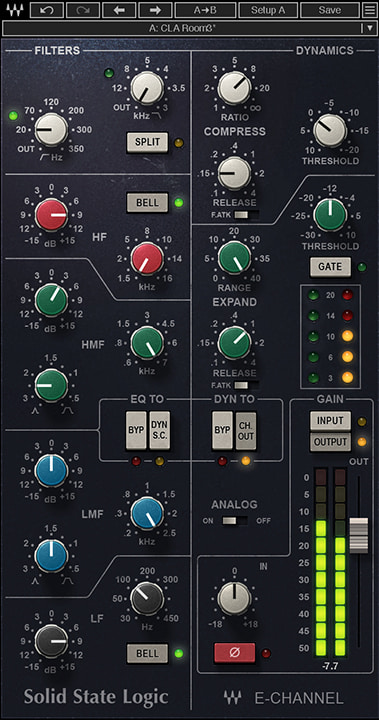
Price: $35.99.
The Waves SSL E-Channel is based on the Solid State Logic 4000-series console’s all-discrete design and its Class A, VCA chip, and these SSL consoles are the ones that have been used throughout the years to create numerous amounts of hits.
The SSL E-Channel is divided up into distinct sections: Filters (these come first in the chain) which can be adjusted to cut off some frequencies depending on the track’s needs, then Compression, and then EQ.
The EQ can be moved in front of the compressor depending on how you want to process the sound by pressing the “Channel Out” button.
The compression section only features four controls: Ratio, Threshold, Release, and the F. Attack Switch, which essentially lets you choose between a slow attack and a slightly faster one (none of them are really that fast).
There are many more controllable parameters on this plugin, like the EQ and the Filters, as well as LMF and HMF peak bands, and more, as I mentioned in the beginning, but I won’t go into detail since we’re mainly focusing on the compressor section. Just know that it’s not just a compressor plugin that works really well for mixing drums, but it’s actually a lot more.
User Interface: The Waves SSL E-Channel is a very simple and straightforward plugin to use and this is mainly because of the interface which essentially looks just like, well, the channel strip of the SLL-4000 console. It only features a handful of knobs and switches and that’s it, and you should be able to use all of its included features in no time.
Character: This plugin does add a bit of character and grit to the signal, which is exactly what I love about it and why I use it on the drum bus.
Distinctive Features:
- Extremely easy to use.
- Zero Latency.
- Includes filters, EQ section, A compressor, and more.
- Great for Drums, vocals, acoustic or electric guitar, and basses.
Uses: The SSL E-Channel is one of the most versatile plugins out there, especially considering how easy it is to use, which means that you can probably get away with using it on any track (I would highly suggest trying it out as a second compressor when processing vocals), but it’s also excellent for drum bus mixing.
You can get the Waves SSL E-Channel here: Waves Website, Sweetwater, Best Service.
Stereo Bus Compressor by MSG
Simple Compressor that works well on the Drum Bus!
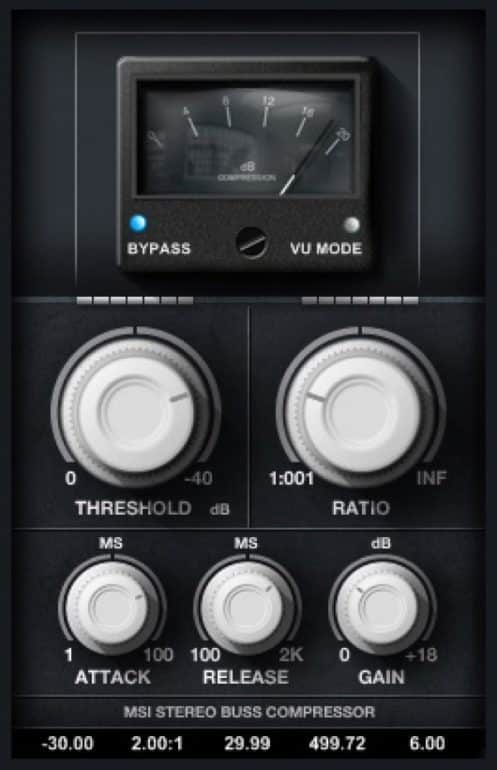
Price: Free.
While being designed as a Mastering compressor, the Stereo Bus Compressor by MSG works wonders on the Drum Bus (I was just trying it on a couple of mixes and it actually works really well!).
There is just one thing I don’t really like too much which is that the metering isn’t all that great. I mean, it shows you the levels and the gain reduction but the needle moves way too quickly, it’s not “smooth”, but that’s just a minor inconvenience to be honest.
It offers the typical compressor controls, such as Threshold, Ratio, Attack, Release, and Makeup Gain, and that’s about it, really!
A bus compressor’s job is to help your mix sound more “glued”, and when trying it both on the drum and mix bus, it actually did just that with ease (just remember to go easy on the compression, you don’t want it squashing the life out of the performance).
User Interface: It’s as simple as it gets: A handful of knobs, simple metering, and that’s it!
Character: Bus compressors are not designed to add any sort of character since that’s something you aim for while mixing, but when mastering you’re only adding some final touches and the compressor used here should be transparent (and this one sounds transparent).
Distinctive features:
- Analogue Modelled Buss Compressor.
- The MSI Stereo Buss Compressor can be used on the Master Buss and also on sub-groups (Drum Groups etc).
- Visual feedback (not the best, though).
- Great sound.
- They say it comes with presets but I couldn’t find them.
Uses: Since it is a “Bus” compressor, it’s mainly designed to glue the mix together, or in other words, to make it sound like a mix and not like separate tracks playing together, and to achieve this you need to add just a tiny bit of compression and not go overboard with the effect.
You can get the Stereo Bus Compressor here: Pluginboutique.
L2 Ultramaximizer
One of the Best Limiter Plugins out there!

Price: $29.99.
Some producers say that they prefer using a limiter on their drum bus instead of a compressor, and while that may be more of a personal taste kind of thing, it’s definitely something you can do as well and should try.
Waves released L2 Ultramaximizer back in 2000, since then it has been bringing consistently awesome squashing for a bargain.
User Interface: L2’s interface has a somewhat outdated look to it. It is, however, simple to learn and is one of the most beginner-friendly limiters out there. It offers control over threshold, ceiling, and a release with ARC.
Character: This is not the most transparent limiter, but the coloring it adds is quite pleasant, which is why I included it in this list since some form of coloration and character can work really well on the drum buss.
Distinctive Features:
- Increased Digital Resolution with double precision bit re-quantization and dither with 9th-order noise shaping filter.
- Manual and ARC™ Automatic Release Control.
Uses: By using a limiter, you can create more size in your sound, making your overheads sound bigger and your snare/kick more aggressive. It’s important, however, that your limiter gets applied after the compressor since running it in front will only accentuate the inconsistencies in levels between each hit.
You can get the L2 Ultramaximizer here: Waves Website, Sweetwater, Best Service.
Honorable Mentions
Torque
Tunes out of Tune Drums!
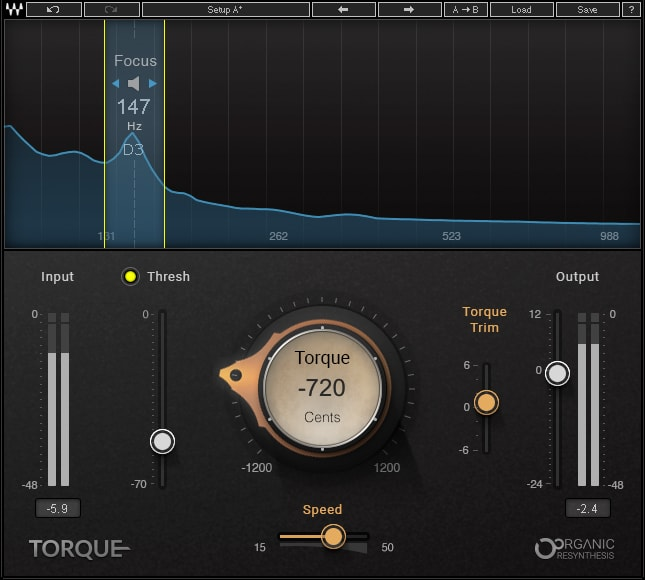
Unless you’re used to mixing music that was recorded in a high-end studio by pro musicians, then the drum tracks you get may be slightly out of tune, and this is where Torque comes in.
Torque is a precision drum tone shifter plugin that lets you tune the drums during the mixing process.
It detects and analyzes the drums’ formant, amplitude, and carrier information, reassembles it, and allows you to manipulate the tonal and pitch characteristics, all while preserving the natural attack, resonance, and duration of the original sound.
User Interface: Just like all the Waves plugins I’ve used over the years, Torque has one of the simplest interfaces there is; With just a handful of controls that let you adjust the threshold, shift the “pitch” or formant of the drums, adjust the speed, torque trim, and output, it’s really simple to use.
Distinctive Features:
- Tone shifter for acoustic and electronic drums
- Adjusts drum timbre & pitch without retriggering or replacing
- Accurately shifts by +/- 1200 cents (12 semitones / 1 octave)
- Zero-latency.
Uses: If the drums you recorded are completely out of tune, then I’d recommend recording them again. However, if only a couple of parts of the kit are slightly out of tune, Torque will do a fantastic job at correcting this.
You can get Torque here: Waves Website, Sweetwater, Best Service.
THR LowEnhance
Specifically designed to process low-end quickly!
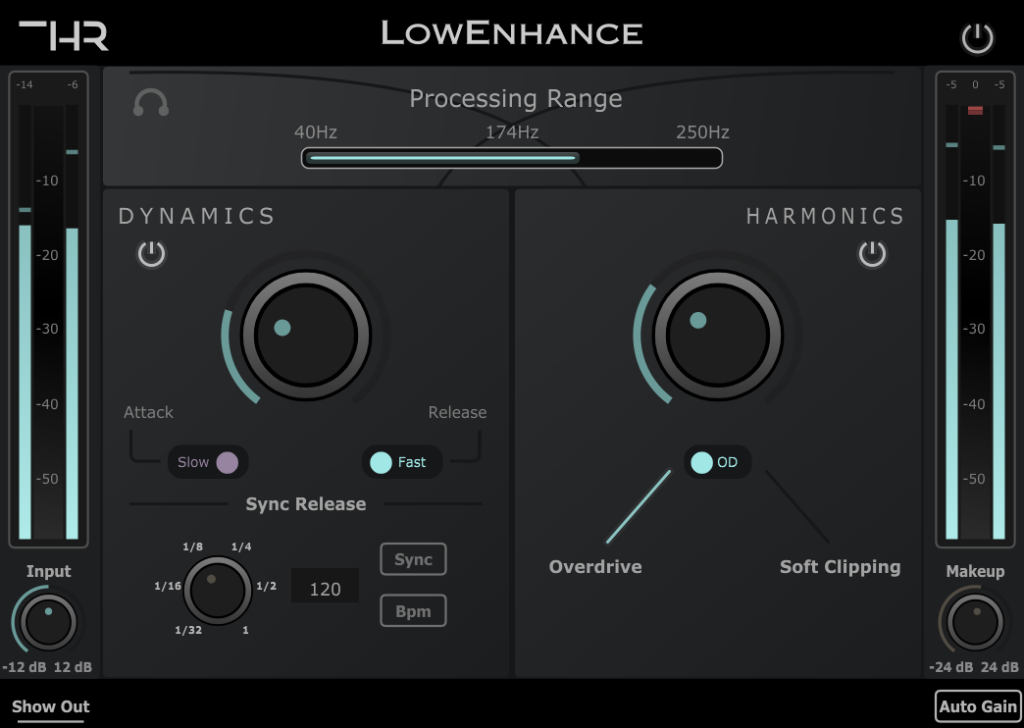
Price: $39.99.
The THR LowEnhance compressor was designed specifically to process the low-end of your tracks and mixes while making the whole process as simple as possible, helping you work at a faster pace without having to fiddle around with dozens of plugin parameters.
Its automatic gain makeup functionality works extremely well and lets you to dial in the needed compression without having to worry about the output volume, and contrary to other compressors, it doesn’t only take into account the threshold and ratio in order to calculate the makup, but also attack and release times.
In order to keep things simple, only fast & slow attack and release times are built in, which should cover most of your needs, but in addition to that, the LowEnhance features tempo-sync functionality, which sets the release time to 1/8th notes, 1/4 notes, etc., based on the project’s tempo.
THR LowEnhance also comes with a distortion module that lets you choose between two types of distortion (Overdrive and Soft clipping), and the output volume also gets automatically compensated so that you don’t have to manually control it.
Some audio recording software, such as Audacity, don’t notify the plugin about the project’s tempo, which is why you can also manually set the tempo in the plugin to achieve the same results.
Lastly, THR LowEnhance allows you to select the exact frequency range you want it to process (from 40Hz and below, up to 250Hz) so that you can accurately control the sound how you want to, and it also lets you solo that frequency range (or band) to have a more thorough listen.
User Interface: The LowEnhance was designed to look and feel simple. It offers simple controls that do what they are supposed to and all of this in an intuitive manner.
Character: While LowEnhance can sound quite mean and dirty when the saturation is cranked, I wouldn’t say it naturally adds character (unless you’re adding saturation, of course) since the compressor itself has a very clear sound that doesn’t add any coloration.
Distinctive Features:
- Automatic gain makeup.
- Compression plus distortion modules.
- Tempo-synced release.
- Low filter band that lets you adjust the specific frequency range to process.
Uses: LowEnhance, as the name implies, was designed to make adding compression and saturation to the low-end as simple of a process as possible: It can be used to add thump and power to you kick drum, help your bass guitar sit better in the mix, or to add some grit and power to your synth lines.
Lastly, LowEnhance comes with a 7-day free trial, so make sure to give it a try!
Find out more about LowEnhance here.
Conclusion
Learning how to mix requires you to learn all the ins and outs of the plugins you’re using, so I’d recommend only grabbing a handful (don’t use 10 compressors, 12 EQs, etc., just choose one or two of each and practice with them) and learning how they work and how they sound.
If you want to make things easier, just go with the CLA Drums plugin by Waves since it features everything you need in order to mix drums, and if you want a great way of targeting the kick drum, add compression and saturation to it, then get the THR LowEnhance.
Lastly, I’d recommend checking out the THR Compactor since it provides you with a clear visual representation of the compression plus it includes a ton of unique features not available on other compressors.
Also, if you’re interested in learning how to properly mix the drums, then I’d recommend you read my guide on it: How to mix Drums.
If you prefer starting with free plugins, then I’m all for it, in fact, here are some articles I wrote where you can find dozens of free ones:
